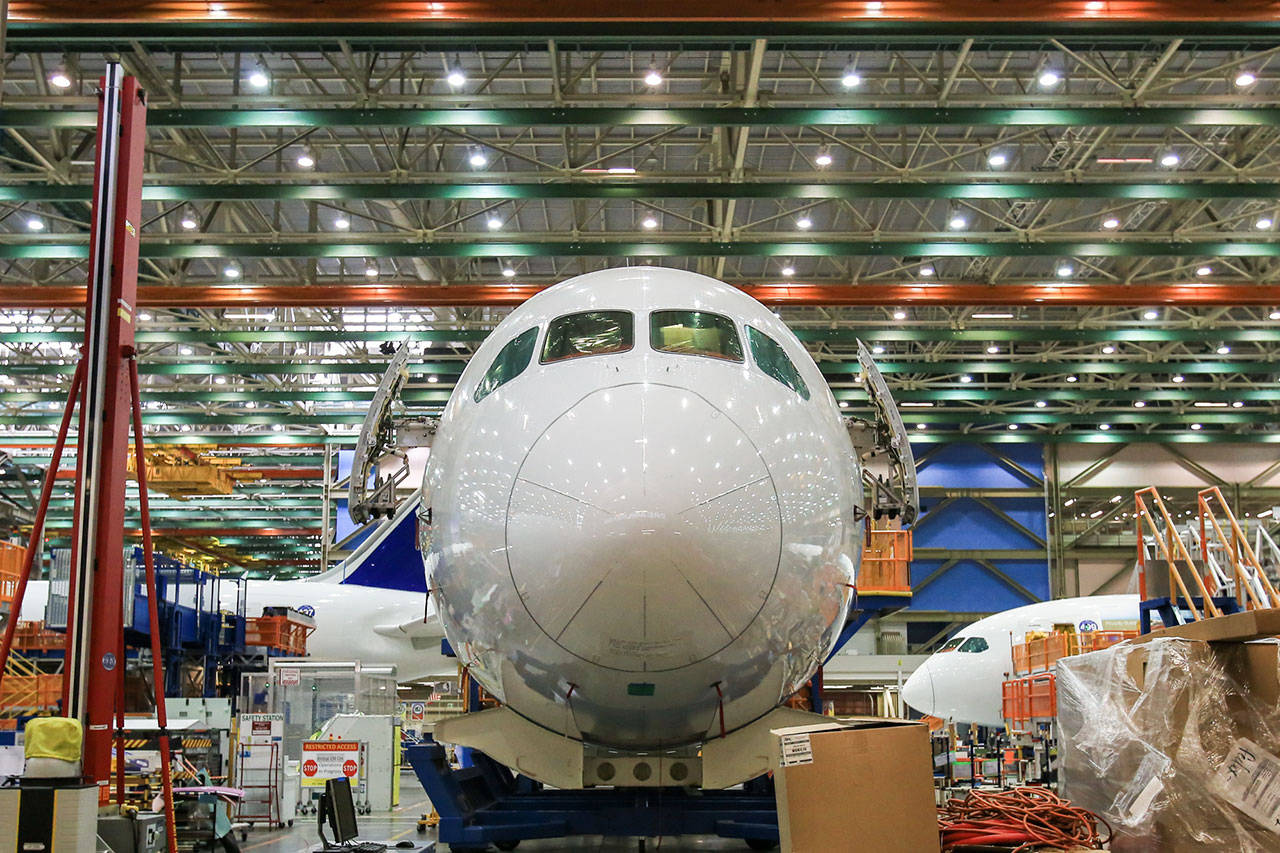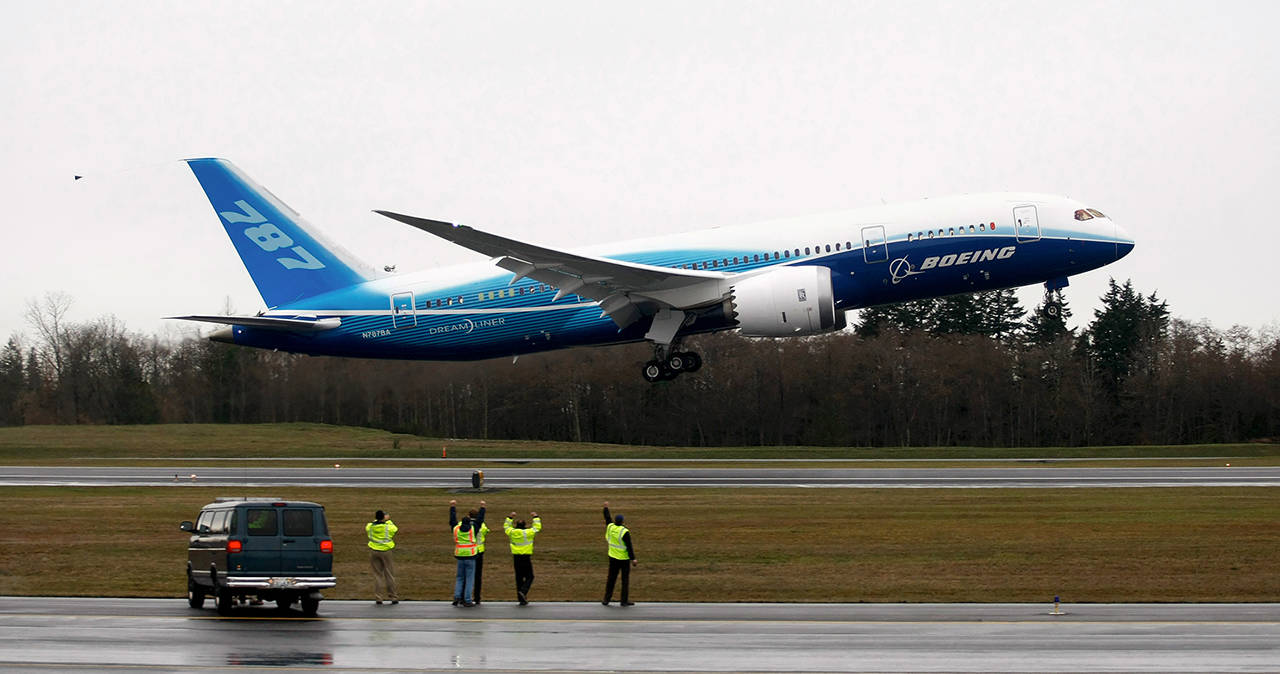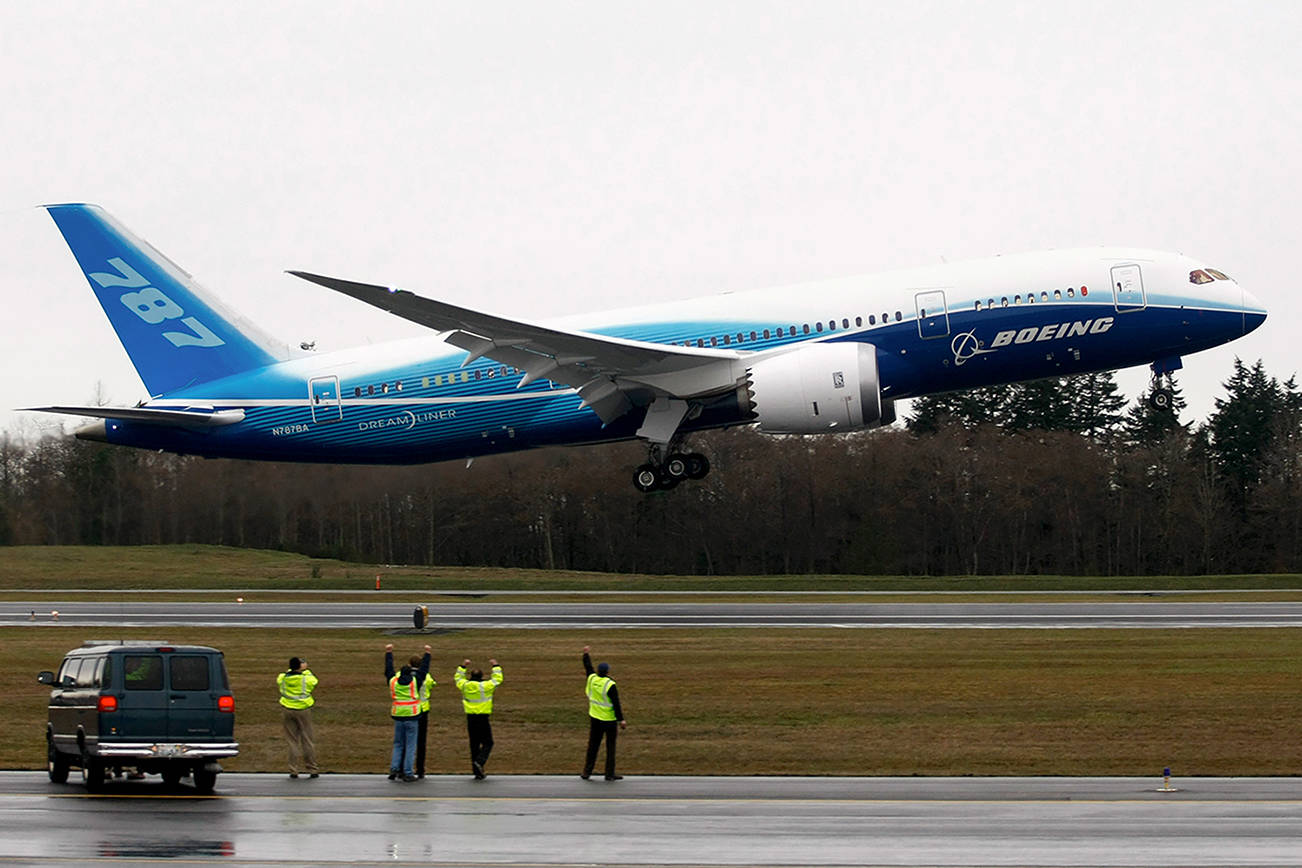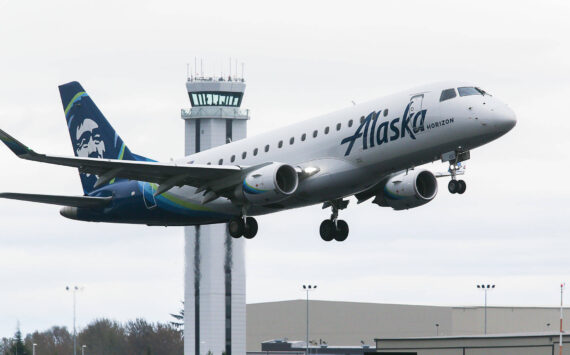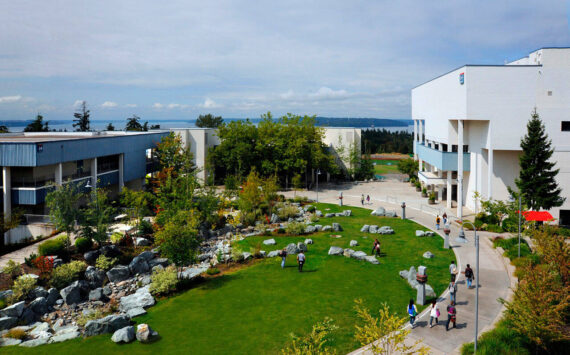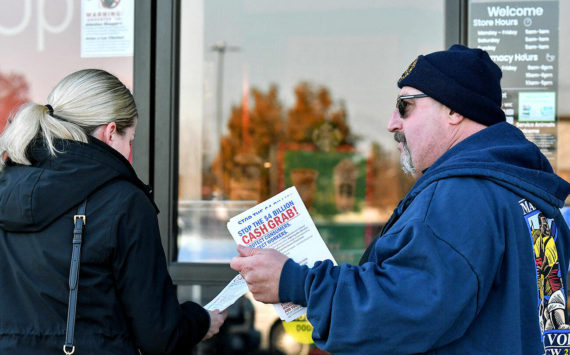EVERETT — A report that the Boeing Co. will stop building the 787 Dreamliner in Washington state and move production to South Carolina has angered state and local leaders who foresee thousands of job losses throughout Washington.
Late Tuesday (Sept. 29), The Wall Street Journal reported that Boeing planned to end a shared production schedule that split manufacture of the twin-aisle airplane between the Everett assembly plant at Paine Field and Boeing’s factory in North Charleston, South Carolina.
Gov. Jay Inslee said, if true, the disappointing decision could jeopardize as many as 1,000 jobs and force the state to review its long-term partnership with Boeing, which would include taking “a hard look at the company’s favorable tax treatment.”
Boeing has received hundreds of millions of dollars in tax breaks from Washington state since lawmakers authorized incentives in 2003.
It would also open the door for further aerospace layoffs in Snohomish County and beyond.
The Everett campus employed about 35,000 people in three shifts at the beginning of the year.
The Wall Street Journal did not provide a time frame for the move, but said Boeing could announce a decision on the 787 as soon as this week.
State and local officials called any decision to move production to South Carolina another blow to the region’s economy already reeling from the COVID-19 pandemic.
In a statement, Inslee said, “Boeing would be turning its back on the finest workers and the best place in the world to build airplanes,” in favor of an “allegiance to short-term profits and Wall Street — not quality, safety and a vision for the future of the industry.”
Boeing declined to comment Tuesday on the Wall Street Journal report.
In an email response for this story, Boeing spokeswoman Jessica Kowal repeated the company’s earlier statement.
“As we have said before,” Kowal wrote, “we will prudently evaluate the most efficient way to build airplanes, including studying the feasibility of consolidating 787 production in one location.
“We are engaging with our stakeholders, including the unions, as we conduct this study,” the company statement continued. “We will take into account a number of factors and keep an eye on future requirements as we think through the long-term health of our production system. Boeing remains committed to Washington state and South Carolina.”
Boeing officials met Sept. 30 with the president and other leaders of the International Association of Machinists and Aerospace Workers District 751.
Larry Brown, President of the Washington State Labor Council, AFL-CIO, and a former Boeing employee said in a statement that the council,“will continue to make the case that Washington remains the smart choice for its 787 assembly,” until Boeing makes a formal announcement.
“Because of the pandemic, the company is already experiencing a significant talent drain by laying off experienced Machinists and Engineers,” Brown said. “It would be a mistake to accelerate that loss of expertise by shifting production away from Washington.”
Meanwhile, Stephen Dickson, head of the Federal Aviation Administration, was at the former Boeing Field in Seattle on Wednesday for a test flight of the revamped 737 Max. The agency is considering whether to allow Boeing’s single-aisle jet to return to service after being grounded since March 2019, following two crashes that killed 346 people. Boeing hopes to win FAA approval later this year for changes it made to the plane’s flight control software, which contributed to the two crashes. .
The Chicago-based company, which employs about 70,000 people in Washington, has laid off about 10,000 employees throughout the state so far this year
If the 787 assembly line closes, thousands of additional job losses could rock the region and reverberate with further losses at 1,200 companies across the state, including 200 Snohomish County businesses that are part of Boeing’s supply chain.
With the 787 program shuttered, the Everett assembly plant would still produce the 767, KC-46 Pegasus, 777 and 747 series.
But the decision would create an enormous vacuum at the Everett plant. The largest building in the world by volume could feel very empty with 787 production eliminated and with the final 747 due to roll off the assembly line in 2022. The looming vacancy has led some to wonder if Boeing might move Renton operations to the Everett plant.
“There’s talk that with the 787 and the 747 going away that Boeing may move 737 production up to Everett,” said a Boeing worker who declined to be identified, because he did not have the company’s authorization to comment.
Workers at the Everett plant, he said, “are upset and concerned about Boeing moving the 787.”
Since July, when Boeing announced its intention to evaluate consolidating 787 production in one location, state and local officials have pleaded with the airplane maker in an effort to keep production here.
On Tuesday, before the Wall Street Journal report, Gov. Jay Inslee told a Snohomish County group that he and other state officials repeatedly asked Boeing what could be done to keep 787 production here.
“We have extended a hand to the Boeing Co.,” Inslee told participants at an Economic Alliance Snohomish County virtual gathering. “To date, they have not given us any ideas about that. We continue to ask Boeing what we can do. Every aerospace job is precious in this state.”
U.S. Rep. Rick Larsen, responding to the Wall Street Journal story, released a statement.
“Boeing’s decision to pull its 787 production out of Washington state is shortsighted and misplaced,” said Larsen, who chairs the House Subcommittee on Aviation. “The Pacific Northwest is home to the best aviation and aerospace workforce in the world.”
Snohomish County Executive Dave Somers said Wednesday, “We are concerned for every 787 employee or supplier who works in Everett. COVID-19 has pushed our economy into unwelcome and uncharted territory, and this is a another blow.”
The devastating decision, again if true, would not necessarily be unexpected.
In July, Boeing CEO David Calhoun said the company was considering whether to consolidate production of the 787. Many analysts predicted South Carolina would be Boeing’s choice.
Analysts have noted for years that labor and manufacturing are less expensive in South Carolina. The North Charleston plant is not unionized, though the Machinists have tried to organize there. The Southeast United States has emerged in recent years as a manufacturing center for the aerospace and luxury auto industry, two sectors that depend on a skilled workforce.
In 2016, Boeing’s European rival Airbus opened a final assembly plant for its A-320 series of narrow-body jets in Mobile, Alabama. European car makers Mercedes-Benz and BMW operate plants in Alabama and South Carolina, both right-to-work states that allow employees to work at a unionized shop without having to join the union or pay union dues. Like Boeing’s South Carolina plant, the Airbus plant in Mobile is not unionized.
The North Charleston plant assembles only 787s. It is the sole location outside of Washington where the company does final assembly of commercial airplanes. It employed about 7,000 people at the beginning of the year.
M3 with crowd of people
Since March, the COVID-19 pandemic has shattered the airline and travel industry. Average daily airline passenger counts are down 50% or more from what they were a year ago.
With demand for new airplanes tabled, Boeing said in July it would reduce production rates for some models in 2021, including the 777, the new 777X and the 787.
Beginning next year, production of the 787 Dreamliner will be cut from 10 per month to six per month.
Boeing followed up the rate reduction with an announcement that it was evaluating whether to consolidate production of the twin-aisle 787 in one location.
Boeing foresaw little need for two assembly plants. The low output — six planes per month — can be handled by the North Charleston plant alone.
The Everett plant and the North Charleston plant, which began operating in 2011, share production of two of three 787 sizes — the 787-8 and the 787-9.
The “stretch” version of the passenger jet, the 787-10, is built only at the North Charleston facility, where fuselages for all 787s are fabricated.
In headier times, the two plants combined produced about 15 of the 787s a month.
Boeing has delivered about 1,000 of the 787s and has orders for 526 more, according to the company website.
Production of the iconic 747, which spawned the sprawling Boeing assembly plant at Paine Field in the 1960s, is due to end in 2022.
About a dozen of the jumbo planes are left to build.
The history of the 787 in Washington is fraught with controversy.
In 2003, state lawmakers authorized $3.2 billion in incentives — tax breaks intended to persuade Boeing to build the 787 here. Six years later, in 2009, Boeing stunned Washington state when it announced plans to build a second 787 assembly plant in South Carolina.
The largest of the tax breaks was eliminated this year.
In February, Boeing asked state lawmakers to suspend a preferential business-and-occupation tax rate, which the World Trade Organization targeted as an illegal trade subsidy.
State lawmakers complied, ending a generous tax break that has saved Boeing hundreds of millions of dollars in recent years.
The decision to move all production of the 787 to South Carolina — should it occur — could be a cause for concern for some buyers. The South Carolina plant has drawn the scrutiny of the Federal Aviation Administration over safety issues related to the production and assembly of 787s built there. Federal regulators are investigating the lapses at the North Charleston facility.
As of August 31, deliveries of new airliners — a critical source of cash for Boeing — were down by more than two-thirds from last year.
Boeing recorded 67 orders but also 382 cancellations, mostly for the troubled Max, which is built in Renton, as of Aug. 31.
The pandemic has compounded Boeing’s problems, on the heels of the Max crashes and the grounding of that airplane model.
The company has been forced to lay off thousands of workers and cut spending.
